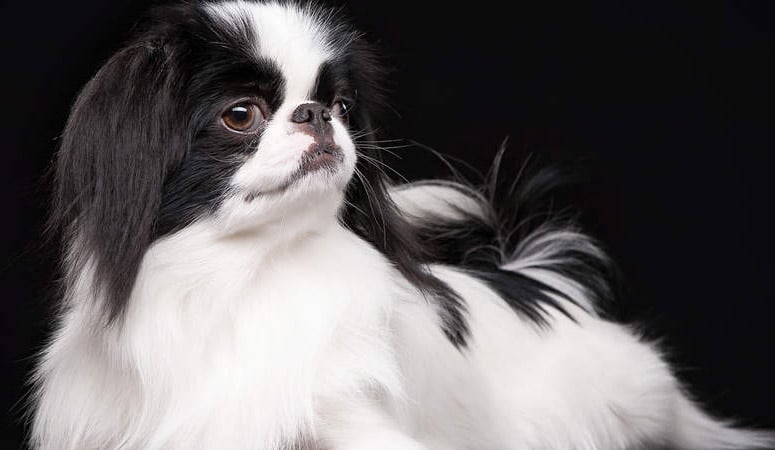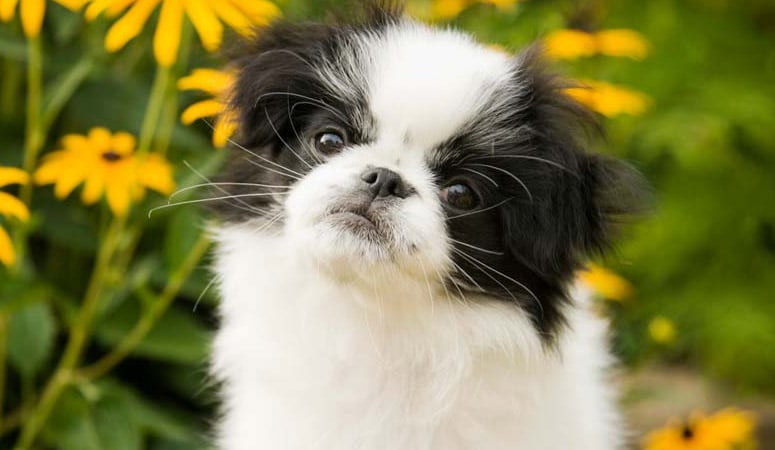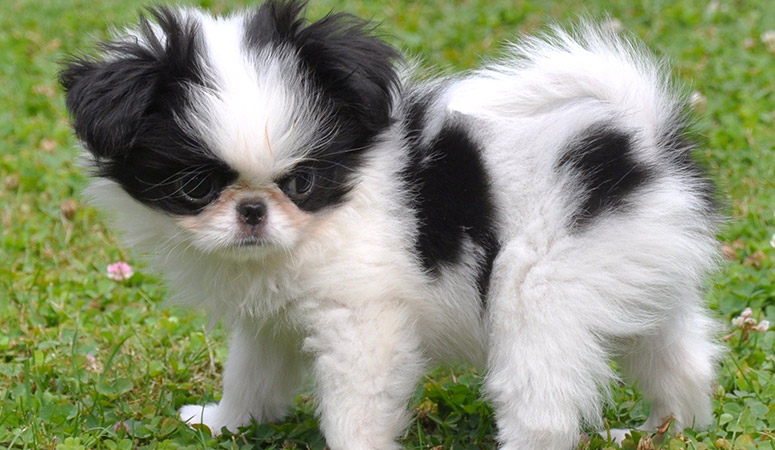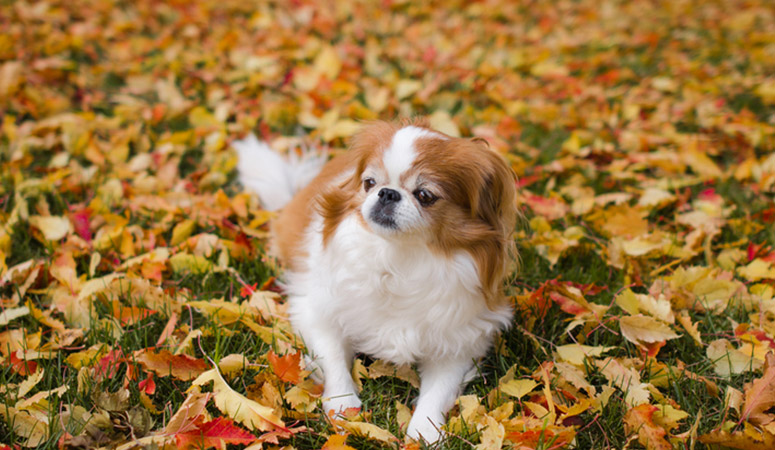Japanese Chin
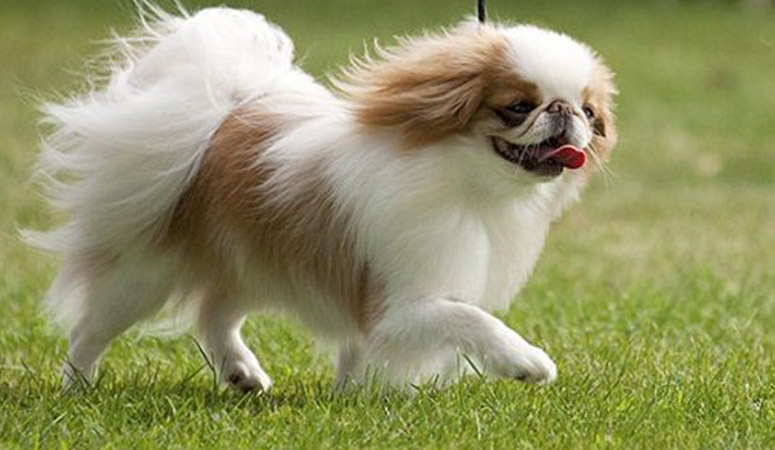
Known as a Japanese Spaniel, the Japanese Chin is a joy of a toy breed with a silky coat, square-proportioned small size and a bright inquisitive expression. The breed has been charming people from as far back as 700 AD and were long the favored companions of Japanese nobility. Though usually quiet, Chin are alert and will bark at visitors and unusual noises.
| Other Names | Chin, Japanese Spaniel |
| Color | Black & White, Lemon & White, Sable & White, White & Black |
| Height | Males: 8-12 inches. Females: 8-11 inches. |
| Weight | Males: 4-15 pounds. Females: 4-15 pounds. |
| Life Span | 10-12 years |
| Personality | Charming, Noble, Loving |
| Exercise | Regular Exercise |
| Origin |
| Popularity | #108 |
| Groom Needs | Weekly Brushing |
| Kids Friendly | No |
| Dog Friendly | Yes |
| Watch Dog | |
| Family Dog | |
| Litter Size | 1 to 3 puppies |
Japanese Chin Pictures
Japanese Chin Video
Introduction
The Japanese Chin Dog is small, playful, proud, and a whole lot less yappy than some of the other toy breeds to which he belongs. He loves to play around at home and doesn’t need a whole lot of exercises; just make sure your yard is well fenced. He comes from a line of spaniels and will more than likely want to dart off and chase a bird or a butterfly down the street! He is a great companion, enjoys cuddling on laps and snuggling with you at home. Still, on the other side, he is an agile climber and you will find him like a cat, graceful and light on his little feet. He stands at around 11 inches at the shoulders and weighs in at around 11 pounds. He can quite literally leap from your arms and damage himself, so watch out for this nimble little fellow. Senior citizens love this pet as he offers attention and interaction, and they love to give it back. He’s not really for small children; he gets easily overwhelmed and can’t take it when kids rough-handle him or tease him. His lovely feathered coat can be black, white, or red, requiring grooming regularly and occasional trimming.
Living with Japanese Chin
With long, silky coat, the Japanese Chin has a high-maintenance appearance of but he is surprisingly easy to maintain in top condition. Begin accustoming your Japanese Chin to being brushed and examined when he’s a puppy. Make grooming a positive experience filled with praise and rewards, and you’ll lay the groundwork for easy veterinary exams and other handling when he’s an adult.
Brush the coat upward and outward with a pin brush to keep hair from tangling. They’re good to go.
Bathing once a month is enough. Dry shampoos will help keep them looking and smelling great. You can also use a mild shampoo, towel them until they’re almost dry.
Trim his nails once or twice a month if your dog doesn’t wear them down naturally to prevent painful tears and other problems. Dog toenails have blood vessels in them, and if you cut too far you can cause bleeding — and your dog may not cooperate the next time he sees the nail clippers come out. So, ask a vet or groomer for pointers if you’re not experienced trimming dog nails.
Handle his paws frequently — dogs are touchy about their feet — and look inside his mouth.
Brush your Japanese Chin’s teeth at least two or three times a week to remove tartar buildup and the bacteria that lurk inside it. Daily brushing is even to prevent gum disease and bad breath.
His ears should be checked weekly for redness or a bad odor, which can indicate an infection and wipe them out with a cotton ball dampened with gentle, pH-balanced ear cleaner to help prevent infections. Don’t insert anything into the ear canal; just clean the outer ear.
As a fairly active little dog, Japanese Chin require very little exercise. A healthy Japanese Chin requires about 20 minutes of light exercise every day.
Chin are known to climb on furniture and find unusual nooks to hide in, so be careful where you sit or step, because they are so diminutive.
He will enjoy going for slow walks with his humans or exploring his fenced backyard. Because of their stubborn nature, it is never a good idea to allow them to outdoors off the lead. If they see something they want to explore, they are likely to refuse to listen to any commands or please.
Japanese Chin enjoy outdoor adventure and playing in the yard. A few rounds of hide and seek in the house and several short walks will keep them fit.
The breed is an excellent choice for apartment living. Chin should live indoors with the rest of their family. But don’t expect much alone time when living with a Japanese Chi, who wants to be near you almost all the time, either playing or snuggling.
Though their single coats are abundant, they don’t provide enough protection from frigid temperatures, so Chin benefit from wearing a dog jacket in winter. Be aware your Chin can’t tolerate the heat and must be kept indoors in the air conditioning when it’s hot and humid.
The Japanese Chin needs high-quality dog food to satisfy its nutrition needs and maintain active. Recommended daily amount is about 1/4 to 1/2 cup a day, divided into two meals. But you’ll need to feed your dog according to his size, age, activity level and metabolism, split between two meals.
The quality of dog food you buy also makes a difference — the better the dog food, the further it will go toward nourishing your dog and the less of it you’ll need to shake into your dog’s bowl.
It is important when you are feeding your Japanese Chin that use choose a food that is high in fiber, or your dog may suffer from impacted anal glands when their diet lacks good dietary fiber.
The Chin does not tend to guard their food, but children should never be allowed to touch or remove food while any dog is eating.
Some dogs are prone to getting overweight, so watch your dog’s calorie consumption and weight level. Although treats can be an important aid in training, but you should never give too many which can cause obesity.
Clean, fresh water should be available at all times.
Learn about which human foods are safe for dogs, and which are not. Check with your vet or the dog’s breeder if you have any questions or concerns about your dog’s weight or diet.
The Japanese Chin is a generally healthy breed, but they are prone to certain health conditions, just like other breeds, such as atrioventricular endocardiosis (a degenerative heart disease), heart murmurs, legg-calve-perthes disease, patellar luxation, eye issues (including corneal abrasions, cataracts, and progressive retinal atrophy), heat-related illnesses, etc.
Japanese Chin can be affected by a fatal neurological condition called GM2 gangliosidosis, or Tay-Sachs disease. Not all Chin will get any or all of these diseases, but it’s important to be aware of them if you’re considering this breed.
There are several health tests considerations specific to the breed, such as patella evaluation, ophthalmologist evaluation and cardiac exam. Also the DNA test can help breeders identify carriers and plan breedings to prevent the disease from manifesting in their puppies.
Responsible Chin breeders will test their stock for conditions or communicate with other dedicated breeders regularly, working together for breed health and preservation of the breed’s unique qualities.
Total Annual Cost: $2674
Cost is estimated for the first year and may vary depending on many factors, such as dog food, health care, leash, collar, licensing, possible fencing, crates, training and obedience classes, dog-walking, grooming, treats, toys, flea, tick, and heart-worm meds, microchips, etc.
Bred strictly as companions for royalty, the Chin’s only job throughout the breed’s history has been to charm, amuse, and comfort their humans. They are often referred to as “catlike,” which can certainly be visible during training.
Training a Chin can be simple for the trainer who can make them believe they are doing only the things they want to do. With the balance of a cat, Chin do very well in agility training.
They are a bit reserved around new people, pets, and situations, but with proper socialization will enjoy going for romps in a supervised dog park with other small dogs.
As companion dogs and very attached to their people, the Chin should not live outdoors or in kennels or they many suffer from separation anxiety.
Always train them with positive reinforcement, dog treats, and praise, because they are sensitive to harsh treatment and will become stubborn in response. Training sessions must be interesting and fun to keep their attention. They love to learn tricks to perform for their adoring public.
They can be difficult to housetrain but with patience and consistency, you can generally expect them to be housetrained by 4 months of age. Chin are smart and eager to please, and will learn the basics quickly.
Japanese Chin are not built for the hunt.
History
It is believed that the Japanese Chin Dog originated from China. But it was found in both the Japanese and Chinese royal courts, greatly favored for its elegant, dainty looks, gentleness and playfulness.
There are two classes of Japanese Chin, ones that are over 7 pounds and those that are under.
There are many stories of how the Chin came to be in Japan. It is said that Zen Buddhist instructors brought this dog to Japan after 520 A.D. Others say a Korean prince in 732 A.D. brought them to Japan. Then others believe that a Chinese ruler gave two dogs to an empress from Japan thousands of years ago. Whatever you believe, it was the Japanese Imperial family that loved these dogs, keeping them as lapdogs, or just as ornaments around the place.
The dogs arrived in Europe around 1853 when Commodore Perry presented Queen Victoria with a pair after visiting Japan. After that, many Chins were brought to be sold in Europe and America.
When future King Edward VII of Great Britain married Alexandra in 1863, she loved the Chin dearly, helping them gain popularity in Great Britain and America.
The AKC recognized the breed in 1888.
It is quite popular in the USA, being registered at the American Kennel Club in 1888.
Helpful Information
Breed Club: JAPANESE CHIN CLUB OF AMERICA
Breed Club Link: https://japanesechinclub.org/
Breed Club Rescue: JCCARE
Breed Club Rescue Link: https://www.japanesechinrescue.org/

